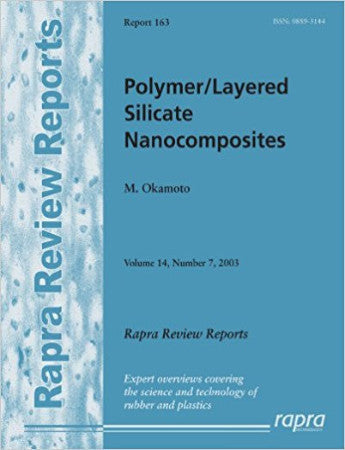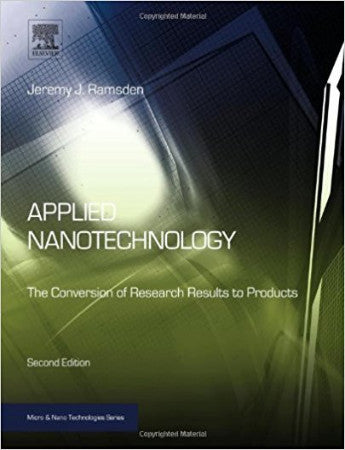Polymer/Layered Silicate Nanocomposites
Polymer/clay nanocomposites have received a lot of attention over the last decade. Companies such as Nanocor and Honeywell are already commercially exploiting nanocomposite materials. A small amount of nanodispersed filler leads to an improvement in material properties, such as modulus, strength, heat resistance, flame retardancy, and lowered gas permeability. Adding clay nanofillers to biodegradable polymers has also been shown to enhance compostability.
The enhancement of material properties has been linked to the interfacial interaction between the polymer matrix and the organically modified layered silicate filler structure. The filler particles provide a very high surface area.
Montmorillonite, hectorite, and saponite are the most commonly used layered silicates. For a nanocomposite to be formed successfully, the mineral must disperse into separate layers. The surface chemistry is also important - ion exchange reactions with cations (commonly alkyl ammonium or alkyl phosphonium cations) allow the silicate to be compatibilised with the polymer matrix. The strong interactions between the two materials lead to dispersion at the nanometre level.
Polymer/layered silicate nanocomposites are prepared by a variety of routes. One of the first materials, a Nylon 6 nanocomposite, was prepared by in situ polymerisation of -caprolactam in a dispersion of montmorillonite. The silicate can be dispersed in a liquid monomer or a solution of monomer. It has also been possible to melt-mix polymers with layered silicates, avoiding the use of organic solvents. The latter method permits the use of conventional processing techniques such as injection moulding and extrusion.
Nanocomposites have been formed with a wide variety of polymers including: epoxy, polyurethane, polyetherimide, poybenzoxazine, polypropylene, polystyrene, polymethyl methacrylate, polycaprolactone, polyacrylonitrile, polyvinyl pyrrolidone, polyethylene glycol, polyvinylidene fluoride, polybutadiene, copolymers and liquid crystalline polymers. Summaries of the work carried out on these different materials and references to these studies are included in this Rapra Review Report.
Many studies have been carried out to characterise different nanocomposites. Techniques in use include wide-angle X-ray diffraction and transmission electron microscopy.
Processing techniques are critical in polymer manufacturing and this holds true for nanocomposites. Several processing methods and innovative techniques are discussed. For example, Nylon 6 clay nanocomposites have been electrospun from solution, which resulted in highly aligned clay particles.
Two other types of nanofiller are briefly described here. Polyhedral oligomeric silsesquioxane (POSS) nanoparticles combine organic and inorganic segments with nanosized cage structures. Carbon nanotubes have also been examined as they offer unique mechanical and electrical properties.
This review is accompanied by around 400 abstracts compiled from the Polymer Library, to facilitate further reading on this subject. A subject index and a company index are included. The majority of these references are cited in the review, which is exceptionally well referenced.
Key features
Nanocomposite structure
Nanocomposite properties
Nanocomposite preparation
Different polymer nanocomposites
Processing nanocomposites
Well referenced
The enhancement of material properties has been linked to the interfacial interaction between the polymer matrix and the organically modified layered silicate filler structure. The filler particles provide a very high surface area.
Montmorillonite, hectorite, and saponite are the most commonly used layered silicates. For a nanocomposite to be formed successfully, the mineral must disperse into separate layers. The surface chemistry is also important - ion exchange reactions with cations (commonly alkyl ammonium or alkyl phosphonium cations) allow the silicate to be compatibilised with the polymer matrix. The strong interactions between the two materials lead to dispersion at the nanometre level.
Polymer/layered silicate nanocomposites are prepared by a variety of routes. One of the first materials, a Nylon 6 nanocomposite, was prepared by in situ polymerisation of -caprolactam in a dispersion of montmorillonite. The silicate can be dispersed in a liquid monomer or a solution of monomer. It has also been possible to melt-mix polymers with layered silicates, avoiding the use of organic solvents. The latter method permits the use of conventional processing techniques such as injection moulding and extrusion.
Nanocomposites have been formed with a wide variety of polymers including: epoxy, polyurethane, polyetherimide, poybenzoxazine, polypropylene, polystyrene, polymethyl methacrylate, polycaprolactone, polyacrylonitrile, polyvinyl pyrrolidone, polyethylene glycol, polyvinylidene fluoride, polybutadiene, copolymers and liquid crystalline polymers. Summaries of the work carried out on these different materials and references to these studies are included in this Rapra Review Report.
Many studies have been carried out to characterise different nanocomposites. Techniques in use include wide-angle X-ray diffraction and transmission electron microscopy.
Processing techniques are critical in polymer manufacturing and this holds true for nanocomposites. Several processing methods and innovative techniques are discussed. For example, Nylon 6 clay nanocomposites have been electrospun from solution, which resulted in highly aligned clay particles.
Two other types of nanofiller are briefly described here. Polyhedral oligomeric silsesquioxane (POSS) nanoparticles combine organic and inorganic segments with nanosized cage structures. Carbon nanotubes have also been examined as they offer unique mechanical and electrical properties.
This review is accompanied by around 400 abstracts compiled from the Polymer Library, to facilitate further reading on this subject. A subject index and a company index are included. The majority of these references are cited in the review, which is exceptionally well referenced.
Key features
Nanocomposite structure
Nanocomposite properties
Nanocomposite preparation
Different polymer nanocomposites
Processing nanocomposites
Well referenced
1.Introduction
2. Layered Silicates
2.1 Structure and Properties
2.2 Organophilic Modification
3. Preparative Methods for PLS Nanocomposites
3.1 Intercalation of Polymer or Pre-Polymer from Solution
3.2 In Situ Intercalative Polymerisation Method
3.3 Melt Intercalation Method<
4. Structure and Characterisation of PLS Nanocomposites
4.1 Structure of PLS Nanocomposites
4.2 Characterisation of PLS Nanocomposites
5. Types of Polymers for the Preparation of Nanocomposites
5.1 Vinyl Polymer Systems
5.1.1 PS/LS Nanocomposites
5.1.2 PMMA/LS Nanocomposites
5.1.3 PVA/LS Nanocomposites
5.1.4 Block Copolymer/LS Nanocomposites
5.2 Condensation Polymers and Rubbers
5.2.1 Nylon/LS Nanocomposites
5.2.2 PCL/LS Nanocomposites
5.2.3 PET/LS Nanocomposites
5.2.4 PBT/LS Nanocomposites
5.2.5 PC/LS Nanocomposites
5.2.6 PEO/LS Nanocomposites
5.2.7 LCP/LS Nanocomposites
5.2.8 PBO/LS Nanocomposites
5.2.9 EPR/LS Nanocomposites
5.2.10 PU/LS Nanocomposites
5.2.11 Polyimide/LS Nanocomposites
5.3 Polyolefins
5.3.1 PP/LS Nanocomposites
5.3.2 PE/LS Nanocomposites
5.4 Speciality Polymers
5.4.1 PANI/LS Nanocomposites
5.4.2 PNVC/LS Nanocomposites
5.5 Biodegradable Polymers
5.5.1 PLA/LS Nanocomposites
5.5.2 PBS/Clay Nanocomposites
6. Properties of PLS Nanocomposite Materials
6.1 Dynamic Mechanical Analysis (DMA)
6.2 Tensile Properties
6.3 Flexural Properties and Heat Distortion Temperature
6.4 Thermal Stability
6.5 Fire Retardant Properties
6.6 Gas Barrier Properties
6.7 Ionic Conductivity
6.8 Optical Transparency
6.9 Biodegradability
6.10 Crystallisation
6.10.1 Spherulite Growth
6.10.2 Effect of Intercalation on Enhancement of Dynamic Modulus
6.10.3 Crystallisation Controlled by Silicate Surfaces
7. Melt Rheology
7.1 Linear Viscoelastic Properties
7.2 Elongational Flow and Strain-Induced Hardening
8. Processing Operations
8.1 Foam Processing Using Supercritical CO2
8.2 Shear Flow Processing
8.3 Electrospinning
8.4 Porous Ceramic Materials
9. Multifunctional Polyhedral Oligomeric Silsesquioxane Nanocomposites
10. Carbon Nanotube Polymer Composites
11. Outlook
Additional References
2. Layered Silicates
2.1 Structure and Properties
2.2 Organophilic Modification
3. Preparative Methods for PLS Nanocomposites
3.1 Intercalation of Polymer or Pre-Polymer from Solution
3.2 In Situ Intercalative Polymerisation Method
3.3 Melt Intercalation Method<
4. Structure and Characterisation of PLS Nanocomposites
4.1 Structure of PLS Nanocomposites
4.2 Characterisation of PLS Nanocomposites
5. Types of Polymers for the Preparation of Nanocomposites
5.1 Vinyl Polymer Systems
5.1.1 PS/LS Nanocomposites
5.1.2 PMMA/LS Nanocomposites
5.1.3 PVA/LS Nanocomposites
5.1.4 Block Copolymer/LS Nanocomposites
5.2 Condensation Polymers and Rubbers
5.2.1 Nylon/LS Nanocomposites
5.2.2 PCL/LS Nanocomposites
5.2.3 PET/LS Nanocomposites
5.2.4 PBT/LS Nanocomposites
5.2.5 PC/LS Nanocomposites
5.2.6 PEO/LS Nanocomposites
5.2.7 LCP/LS Nanocomposites
5.2.8 PBO/LS Nanocomposites
5.2.9 EPR/LS Nanocomposites
5.2.10 PU/LS Nanocomposites
5.2.11 Polyimide/LS Nanocomposites
5.3 Polyolefins
5.3.1 PP/LS Nanocomposites
5.3.2 PE/LS Nanocomposites
5.4 Speciality Polymers
5.4.1 PANI/LS Nanocomposites
5.4.2 PNVC/LS Nanocomposites
5.5 Biodegradable Polymers
5.5.1 PLA/LS Nanocomposites
5.5.2 PBS/Clay Nanocomposites
6. Properties of PLS Nanocomposite Materials
6.1 Dynamic Mechanical Analysis (DMA)
6.2 Tensile Properties
6.3 Flexural Properties and Heat Distortion Temperature
6.4 Thermal Stability
6.5 Fire Retardant Properties
6.6 Gas Barrier Properties
6.7 Ionic Conductivity
6.8 Optical Transparency
6.9 Biodegradability
6.10 Crystallisation
6.10.1 Spherulite Growth
6.10.2 Effect of Intercalation on Enhancement of Dynamic Modulus
6.10.3 Crystallisation Controlled by Silicate Surfaces
7. Melt Rheology
7.1 Linear Viscoelastic Properties
7.2 Elongational Flow and Strain-Induced Hardening
8. Processing Operations
8.1 Foam Processing Using Supercritical CO2
8.2 Shear Flow Processing
8.3 Electrospinning
8.4 Porous Ceramic Materials
9. Multifunctional Polyhedral Oligomeric Silsesquioxane Nanocomposites
10. Carbon Nanotube Polymer Composites
11. Outlook
Additional References
Professor Musami Okamoto is a world-renowned expert in the field of polymer/clay nanocomposites. He is currently a Professor at the Graduate School of Engineering, in the Toyota Technological Institute. He received a Ph.D. in 1994 from the Tokyo Institute of Technology on Structure Development during Melt Processing and Mechanical Properties in Polymer Blends. He has worked at Toyobo Co., where his research programme focused on polymer blends and alloys. He held a postdoctoral post at the National Institute of Advanced Industrial Science & Technology, Kyushu, prior to joining the faculty at Toyota




